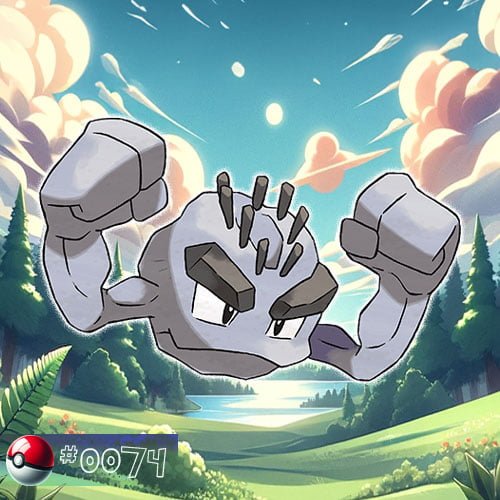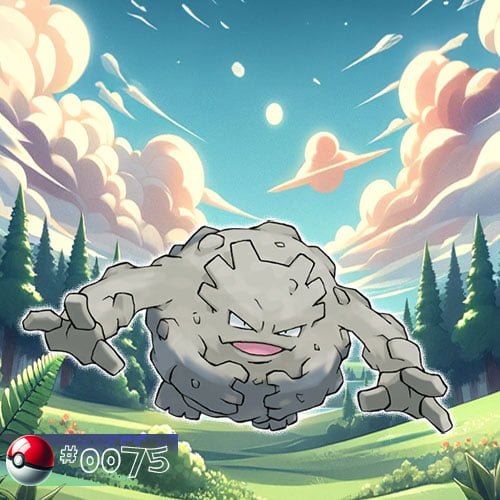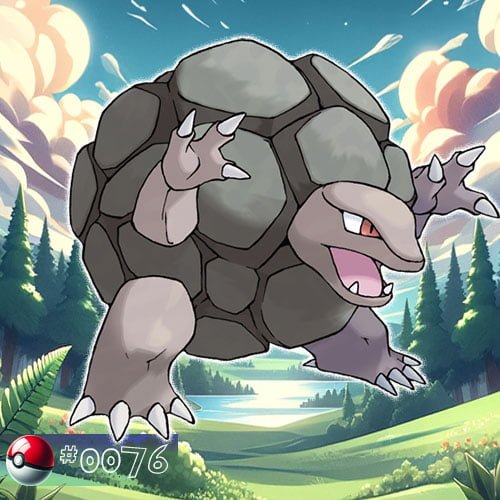Geodude
Geodude is a Rock/Ground-type Pokémon known for its rock-like appearance. It is often found in mountainous regions and caves and is recognizable by its spherical body made of rocky segments and its two muscular arms. Geodude is known for its resilience and strength, and it is a common and iconic Pokémon in the Pokémon series.
Biology
Physical Characteristics
Here are detailed physical characteristics of Geodude.
Geodude is a small and compact Pokémon, reflecting its pre-evolutionary stage. It stands at a height of about 1 foot (0.4 meters) on average. Despite its rock-like appearance, Geodude is relatively lightweight, with an average weight of around 44 pounds (20 kilograms).
Geodude’s body is primarily composed of rocks. It has a spherical shape with distinct rocky segments. The surface of Geodude’s rocky body often has a rough and uneven texture, resembling natural rock formations. Geodude has two short, muscular arms emerging from its body. These arms end in three fingers each.
While Geodude lacks a traditional mouth, its eyes are expressive, conveying various emotions such as determination or focus. Some variations of Geodude feature small, rounded appendages on the top of its head. These may resemble horns or additional rock formations.
Geodude’s coloration is typically brown or gray, resembling common earth tones. The color may vary slightly depending on the specific environment in which it is found.
Alolan form
Alolan Geodude, originating from the Alola region, features distinct physical characteristics compared to its regular form. It has a darker, charcoal-gray coloration, deviating from the typical brownish hue of its Kantonian counterpart.
Alolan Geodude is characterized by metallic, magnetic rocks embedded in its body. These rocks contribute to its Electric/ Rock typing when it evolves into Golem.
Its facial expression may differ slightly, giving it a unique appearance compared to the standard Geodude.

The Alolan form’s design is inspired by the volcanic and geologically diverse landscape of the Alola region, with the magnetic rocks reflecting the unique geological features.
When Alolan Geodude evolves into Alolan Graveler and then Alolan Golem, its Electric/Rock typing is emphasized, bringing a new elemental combination to its evolved forms.
Geodude’s overall appearance gives it a gritty and sturdy demeanor, in line with its Rock/Ground typing. As Geodude evolves into Graveler and eventually into Golem, its physical characteristics undergo significant changes, with the body becoming larger and more rugged.
Geodude’s physical attributes showcase its adaptation to rocky environments and its robust, enduring nature. Its rock-based composition reflects its affiliation with the Rock-type Pokémon, making it a resilient and formidable creature in battles.
Behaviour
While specific details about Pokémon behavior can vary across different media, including games, anime, and other adaptations, here are some general characteristics of Geodude’s behavior.
Geodude is known to inhabit mountainous and cave environments. It exhibits territorial instincts, often defending its habitat from intruders. When threatened, Geodude can adopt a defensive posture by curling into a ball. This defensive stance protects its vulnerable body parts from potential attacks.
Geodude is often active during the night, emerging from caves or rocky areas. Its behavior may include patrolling its territory or searching for food.
Geodude is capable of throwing rocks as a means of defense or during battles. This behavior is a manifestation of its Rock-type characteristics. Geodude is adept at climbing rocks and surfaces, showcasing its ability to navigate and explore its rocky habitat. In battles, Geodude exhibits aggressive behavior, using its Rock-type moves to defend itself or attack opponents. It relies on its physical strength and endurance in confrontations.
Geodude may engage in social behaviors, especially with other members of its evolutionary line, such as Graveler and Golem. Social interactions could involve communication through body language or simple vocalizations.
In colder climates, Geodude may enter a state of hibernation to conserve energy. During this time, it might seek shelter in caves or underground. Geodude may spend time searching for food in its rocky habitat. While specific dietary preferences may not be detailed, its earthy environment likely influences its diet.
As Geodude evolves into Graveler and eventually into Golem, its behavior may undergo changes, with the Pokémon becoming larger, more powerful, and potentially exhibiting different instincts.
It’s important to note that these behavioral characteristics are generalizations, and individual Geodude may exhibit variations based on factors such as environmental conditions and specific circumstances presented in the Pokémon world.
Evolution
Geodude evolves into Graveler starting at level 25. The transformation from Geodude to Graveler brings noticeable changes. Graveler is larger and has additional rocky protrusions on its body. It retains the basic rock-like appearance.
In the traditional Pokémon games, Graveler evolves into Golem through trading. Trading is the essential factor triggering this evolution. In certain game versions or adaptations, alternative methods may exist, such as using an evolutionary item like a “Link Cable” or “Rocky Helmet.”
The evolution into Golem is a significant transformation. Golem is much larger and more formidable compared to both Geodude and Graveler. It gains additional features like arms and legs, making it a more humanoid rock creature. Golem’s rocky exterior is more pronounced, emphasizing its durability.
With each evolution, the Pokémon generally experiences an increase in stats such as HP (Hit Points), Attack, Defense, and overall base stat total. Golem, being the final evolution, typically has higher base stats compared to Geodude and Graveler.
Throughout the evolutionary line, Geodude, Graveler, and Golem maintain the Rock/Ground typing. This typing gives them strengths against various types but also leaves them vulnerable to certain attacks, such as Water and Grass moves.
Geodude, Graveler, and Golem learn a range of moves as they level up, including Rock-type and Ground-type moves. The movepool may vary based on the specific Pokémon version or game.
Golem, being the final evolution, is often considered a more potent and versatile battler compared to Geodude and Graveler. Its increased size, enhanced stats, and broader movepool contribute to its effectiveness in battles.
Alolan form
Alolan Geodude evolves into Alolan Graveler starting at level 25. The evolution signifies a transition in both appearance and capabilities. Upon evolving, Alolan Graveler retains its Electric/Rock typing, maintaining the unique elemental combination.
Trade evolution is required for Alolan Graveler to evolve into Alolan Golem. Trading facilitates Alolan Golem’s transformation, emphasizing social interaction in the evolution process. The inclusion of Electric typing persists in Alolan Golem’s attributes.
Alolan Golem showcases increased size and power compared to its pre-evolutions. The addition of Electric typing enhances its offensive capabilities and strategic versatility. Alolan Golem’s evolution exemplifies the influence of regional adaptations in Pokémon evolution.
The evolutionary line of Geodude overall showcases the concept of growth and progression in Pokémon, with each stage offering unique characteristics and abilities. Evolutionary changes also represent the Pokémon’s adaptation to its environment and the challenges it faces during its journey.
Appearances
Anime Main Appearances
Brock’s Geodude
In the episode “Showdown in Pewter City” Brock introduced his Geodude, marking the species’ anime debut. Throughout his travels in Kanto and Johto, Geodude was a loyal companion. Brock later lent it to his brother Forrest before heading to Hoenn. Geodude made a return under Brock’s command in the Kanto mini-arc featured in “Alola, Kanto!” and “When Regions Collide!”.
Other appearences include:
- “Navel Maneuvers” (Danny enlisted a Geodude to craft and ride a sled for challenges. It reappeared in flashbacks in “A Way Off Day Off” and “Hello, Pummelo!”)
- “Winner by a Nosepass” (Roxanne utilized a Geodude, defeating Treecko during the Gym battle.)
- “Hooked on Onix” (Geodude served King Onix.)
- “Shapes of Things to Come!” (Roark used a Geodude against Paul. It defeated his Azumarill but lost to Elekid.)
- “O’er the Rampardos we Watched!” (Geodude battled Ash‘s Aipom.)
- “Treasure Hunt, Akala Style!” (Ash encountered an Alolan Geodude)
- “Sparking Confusion!” (Geodude, Alolan Graveler, and Alolan Golem caused chaos at Wela Volcano Park.)
- “All Out, All of the Time!” (Goh caught an Alolan Geodude during the Pokémon Catch Adventure Race.)
Anime Minor Appearances
Various appearances in credits, fantasies, and brief cameos include “Pikachu’s Rescue Adventure”, “Type Casting,” “Lucario and the Mystery of Mew”, “Giratina and the Sky Warrior”, and “Arceus and the Jewel of Life”.
In the Laboratory of Professor Oak, a Geodude resided in the episode “Showdown at the Po-ké Corral”. Team Rocket’s fantasy showcased a pink Geodude in the episode “In the Pink”. A Geodude sensed a disturbance in “The Power of One”.
Other instances involve a sick Geodude in “Carrying On!”, a beauty contest fantasy in “Beauty and the Breeder.” and a snowball incident in “A Snow Day for Searching!”. Goh caught a Geodude in “Trials of a Budding Master!” with subsequent appearances in Pokémon Journeys: The Series. Two Geodude made a cameo in “This Could be the Start of Something Big!”.
Multiple Geodude appeared in the espiodes:
- ”Ash encountered an Alolan Geodude in”
- ”Celebi: The Voice of the Forest”
- ”Pokémon Heroes: Latios & Latias”
- ”Steeling Peace of Mind!”
- ”Saving the World From Ruins!”
- ”Genesect and the Legend Awakened” (living at Pokémon Hills, and battling against the Genesect Army)
- ”Alola, Kanto!”
- ”Battling in the Freezing Raid!” (several of them)
A Coordinator’s Geodude was seen in the episode ”Hi Ho Silver Wind!”.
A Trainer’s Geodude appeared also in the following epsodes:
- ”The Joy of Pokémon” (treated by Nurse Joy)
- ”Wired for Battle!” (as an image in Shingo’s laptop)
- ”Training Wrecks” (three of them)
- ”An Old Family Blend!” (participated in the Lily of the Valley Conference)
- ”I Choose You!” (two of them , one owned by Trainer and one wild)
- ”Alola, Kanto!”
- ”Battle Royal 151!” (participated in the Battle Royal preliminary round of the Manalo Conference)
- ”Errand Endurance!”
- ”Take My Thief! Please!”
- HZ039
Manga Appearances
Ash & Pikachu
Roxanne utilizes a Geodude in her Gym battle against Ash. Additionally in this manga, a Trainer’s Geodude made an appearance in the episode titled “Trust In Each Other!!”.
The Electric Tale of Pikachu
Brock utilized two Geodude during his Gym battle against Ash in “Play Misty For Me”.
Pokémon Adventures
In the episode “Onix is On!”, a Geodude was observed floating next to Brock. Later, in the Yellow arc, Brock was seen with a belt formed by six Geodude around his jacket. This Geodude sextet made a return in “The Last Battle III”, attempting to stop the Magnet Train with a combined Magnitude. Each Geodude within the group had individual nicknames, ranging from Geoone to Geosix.
In various other episodes, wild Geodude sightings occurred in locations such as Union Cave (” Off Course with Corsola”). Team Rocket utilized a Geodude in ”Tauros the Tyrant”, and Green discussed Mew in ”The Jynx Jinx”, showing a Geodude silhouette.
Other instances involve appearances in episodes like ”Guile from Mawile”, ”A Conk on Cranidos’s Cranium”, and ”Weavile Wobbles But It Won’t Fall Down”. Geodude sightings were also featured in episodes such as ”Passing by Probopass”, ”Lucky Lucario I” and ”Pinsir Changes”. A flashback in ”Charizard Transforms” showcased a Geodude as well.
Pokémon Diamond and Pearl Adventure!
In the episode ” In Search of the Legendary Pokémon Dialga!!”, a Geodude was spotted. Another Geodude appeared in the ”Beauty Contest: The Pokémon Super Contest!!”. Roark’s Geodude was introduced in a flashback during the episode “Challenge! The Fortress Of Steel!!”, showcasing its support for Roark as a child. It made its physical debut in “Bonds Connect Across Space-Time…”. Additionally, Hareta successfully caught a Geodude during the ”Serious Training on Iron Island”.
Geodude also appeared in the following Pokémon manga:
Magical Pokémon Journey – in the episode ”How Do You Do, Pikachu?”.
Pocket Monsters DP – in the sixteenth chapter of the Pocket Monsters DP manga, PMDP16.
Pocket Monsters HGSS – in the seventh chapter of the Pocket Monsters HGSS manga , PMHGSS07 (owned by Professor Oak).
Pokémon Battle Frontier – in the episode ”Enta Arrives at the Battle Frontier!”.
Pokémon Gold & Silver: The Golden Boys – in the episode ”Let’s Aim For The Goal!”.
Pokémon Gotta Catch ‘Em All – in the episodes ”Catch the Poliwag!” (in a background collage), GDZ21 and GDZ28 (Shu captured one).
Pokémon Mystery Dungeon: Ginji’s Rescue Team – in the episode ”I Want to be Human Again!”.
Pokémon Pocket Monsters – in the episode ”The Legendary Pokémon Appears!!”.
Game data
Stats
Location
| Game version | Location |
|---|---|
| Pokémon Red and Pokémon Blue | Mt. Moon, Rock Tunnel, Victory Road |
| Pokémon Yellow | Mt. Moon, Rock Tunnel, Victory Road |
| Pokémon Gold and Pokémon Silver | Routes 45 and 46, Dark Cave, Mt. Moon, Mt. Mortar, Team Rocket HQ, Rock Tunnel, Union Cave |
| Pokémon Crystal | Routes 33, 45 and 46, Dark Cave, Mt. Moon, Mt. Mortar, Team Rocket HQ, Rock Tunnel, Union Cave |
| Pokémon Ruby and Pokémon Sapphire | Routes 111 and 114, Granite Cave, Safari Zone, Victory Road |
| Pokémon FireRed and Pokémon LeafGreen | Cerulean Cave, Kindle Road, Mt. Ember, Mt. Moon, Rock Tunnel, Sevault Canyon, Victory Road |
| Pokémon Emerald | Routes 111 and 114, Granite Cave, Safari Zone, Victory Road, Team Magma/Aqua Hideout |
| Pokémon Colosseum | Trade |
| Pokémon XD | Trade |
| Pokémon Diamond and Pokémon Pearl | Routes 206, 207, 210, 211, 214 and 215, Iron Island, Mt. Coronet, Oreburgh Gate, Oreburgh Mine, Ravaged Path, Ruin Maniac Tunnel, Stark Mountain, Valor Lakefront, Wayward Cave |
| Pokémon Platinum | Routes 206, 207, 210, and 214, Oreburgh Gate, Ruin Maniac Cave, Oreburgh Mine, Iron Island, Mt. Coronet, Maniac Tunnel, Wayward Cave |
| Pokémon HeartGold and Pokémon SoulSilver | Routes 45 and 46, Cliff Cave, Dark Cave, Mt. Moon, Mt. Mortar, Team Rocket HQ, Rock Tunnel, Ruins of Alph, Union Cave, Victory Road |
| Pokémon Black and Pokémon White | Breed Graveler or Golem |
| Pokémon Black 2 and Pokémon White 2 | Trade |
| Pokémon X and Pokémon Y | Route 18, Terminus Cave, Victory Road |
| Pokémon Omega Ruby and Pokémon Alpha Sapphire | Routes 111 and 114, Granite Cave, Rusturf Tunnel |
| Pokémon Sun and Pokémon Moon | Route 12, Blush Mountain (Alolan Form) |
| Pokémon Bank (Kantonian Form) | Routes 14 and 15, Ancient Poni Path, Poni Breaker Coast |
| Pokémon Ultra Sun and Pokémon Ultra Moon | Breed Graveler or Golem (Alolan Form) |
| Pokémon Bank (Kantonian Form) | Challenge Beach, Fields of Honor, Honeycalm Island, Honeycalm Sea, Insular Sea, Loop Lagoon, Stepping-Stone Sea, Workout Sea |
| Pokémon: Let's Go, Pikachu! And Pokémon: Let's Go, Eevee! | Mt. Moon, Rock Tunnel, Victory Road, Cerulean Cave (Kantonian Form) |
| Trade (Alolan Form) | Islespy Shore, Lunker's Lair, Seagrass Haven |
| Pokémon Sword and Pokémon Shield | Unobtainable |
| Pokémon Brilliant Diamond and Pokémon Shining Pearl | Routes 206, 207, 210, 211, 214 and 215, Iron Island, Mt. Coronet, Oreburgh Gate, Oreburgh Mine, Ravaged Path, Ruin Maniac Tunnel, Stark Mountain, Valor Lakefront, Wayward Cave, Spacious Cave, Rocky Cave, Volcanic Cave, Big Bluff Cavern, Typhlo Cavern |
| Legends Arceus | Deertrack Heights, Oreburrow Tunnel, Aipom Hill, Bathers' Lagoon, Bolderoll Ravine, Bolderoll Slope, Celestica Ruins, Clamberclaw Cliffs, Gapejaw Bog, Ginkgo Landing, Scarlet Bog, Ursa's Ring, Veilstone Cape, Worn Bridge |
| Pokémon Scarlet and Pokémon Violet | Trade |
Geodude's origin name
These names often emphasize Geodude’s rocky composition, small size, and association with stones, showcasing linguistic creativity in capturing its earthy characteristics.
English: Geodude – The English name is a combination of “geo,” referring to the Earth, and “dude,” a casual term. It aptly describes Geodude’s rocky composition.
Japanese: イシツブテ (Ishitsubute) – In Japanese, Geodude’s name is Ishitsubute, combining “石” (ishi, meaning stone) and “つぶて” (tsubute, meaning throwing stones). It reflects its rock-based appearance and its ability to throw rocks.
French: Racaillou – In French, Geodude is known as Racaillou, a term that can be associated with ruggedness or sturdiness.
German: Kleinstein – The German name Kleinstein combines “klein” (small) and “stein” (stone), emphasizing its small, rocky form.
Spanish: Geodude – The Spanish name is the same as the English name, maintaining consistency in many Pokémon names across different languages.
Italian: Geodude – Similar to Spanish and English, the Italian name for Geodude is Geodude.
Korean: 꼬마돌 (Kkomadol) – In Korean, Geodude is known as Kkomadol, where “꼬마” (kkoma) means small, and “돌” (dol) means stone.
Chinese (Simplified): 小拳石 (Xiǎo Quán Shí) – In Simplified Chinese, Geodude is referred to as Xiǎo Quán Shí, which translates to “Small Fist Stone.”
Chinese (Traditional): 小拳石 (Xiǎo Quán Shí) – In Traditional Chinese, the name remains the same as in Simplified Chinese.





